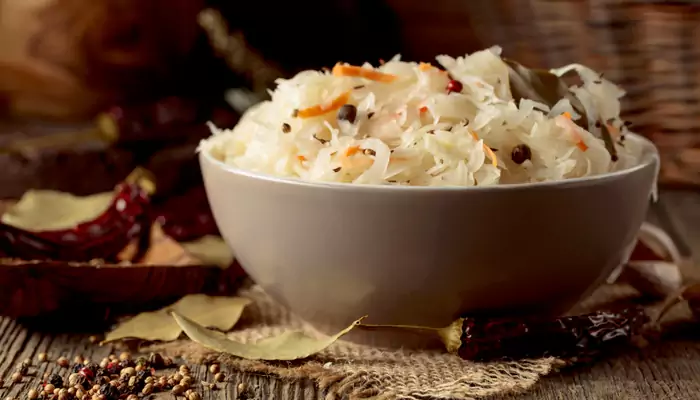Global Flavors: Exploring Pickling Traditions From Around The World
Pickling is an age-old preservation method that transforms ordinary vegetables and fruits into tangy, flavourful delicacies.
- Ishani Karmakar
- 09 May, 2025
- 2 mins ago

Global Flavors: Exploring Pickling Traditions From Around The World
Pickling is an age-old preservation method that transforms ordinary vegetables and fruits into tangy, flavourful delicacies.
Across the globe, cultures have developed unique pickling traditions that reflect their regional ingredients, culinary preferences, and historical practices. Here’s a culinary journey through some of the most fascinating pickling traditions from around the world, showcasing the diverse and delectable flavours that pickling brings to global cuisines.
Asian Delights: Korean Kimchi
Kimchi, a staple of Korean cuisine, is more than just a side dish—it’s a cultural icon. This spicy and tangy fermented vegetable dish is made primarily from napa cabbage and radishes, seasoned with a robust blend of Korean red chili pepper flakes, garlic, ginger, and sauce. The pickling process involves fermenting the vegetables in a briny, spicy mixture for several days to develop its distinctive flavour.
Traditional Preparation
Ingredients
Napa cabbage, radishes, Korean chili pepper flakes (gochugaru), garlic, ginger, and salt.
Process
Cabbage is salted and left to wilt before being mixed with a spicy paste and fermented in jars. The fermentation time varies, but it typically lasts from a few days to several weeks, depending on desired sourness.
European Classics: German Sauerkraut
Sauerkraut, a classic German pickled cabbage dish, is beloved for its tangy flavour and crunchy texture. Made from finely shredded cabbage that is salted and fermented, sauerkraut is a quintessential example of Eastern European pickling tradition.

Traditional Preparation
Ingredients
Cabbage, salt, and optional caraway seeds.
Process
Cabbage is finely shredded, mixed with salt, and packed tightly into fermentation crocks. It is left to ferment at a cool temperature for several weeks. The resulting sauerkraut can be enjoyed on its own or as a flavourful addition to various dishes.
Indian Flair: Achaar
In India, achaar refers to a variety of pickles made from fruits, vegetables, and spices. These pickles are known for their bold flavours, thanks to a mix of spices such as mustard seeds, fenugreek, turmeric, and chili powder. Achaar is often served as a condiment alongside Indian meals.
Traditional Preparation
Ingredients
Mangoes, lemons, or mixed vegetables; spices like mustard seeds, turmeric, and chili powder; oil; and salt.
Process
Ingredients are mixed with spices and oil, then packed into jars and left to mature in the sun. The pickling time varies, but it generally takes a few weeks for the flavours to fully develop.
Middle Eastern Taste: Lebanese Pickled Turnips
Lebanese pickled turnips are a staple in Middle Eastern cuisine, known for their vibrant pink colour and tangy flavour. They are often enjoyed as part of a mezze platter or as a flavourful addition to sandwiches.
Traditional Preparation
Ingredients
Turnips, beets (for colour), garlic, salt, vinegar, and water.
Process
Turnips and beets are sliced and packed into jars with garlic. A mixture of vinegar, water, and salt is poured over the vegetables, and the jars are sealed and left to pickle for about two weeks.
Latin American Twist: Mexican Escabeche
Mexican escabeche is a tangy, pickled vegetable mix commonly served as a side dish or condiment. This pickling method often includes a combination of carrots, onions, and jalapeños, all marinated in a spicy, vinegar-based brine.
Traditional Preparation
Ingredients
Carrots, onions, jalapeños, vinegar, water, garlic, and spices such as bay leaves and oregano.
Process
Vegetables are blanched, then packed into jars with spices and covered with a vinegar brine. The jars are sealed and allowed to sit for at least a week to develop flavour.
Japanese Variety: Tsukemono
Tsukemono, or Japanese pickles, come in many forms, reflecting the rich diversity of Japanese cuisine. These pickles can range from the sweet and tangy umeboshi (pickled plums) to the crunchy and savoury takuan (pickled daikon radishes).
Traditional Preparation
Umeboshi
Plums are salted and dried before being pickled with shiso leaves and additional salt.
Takuan
Daikon radishes are salted, dried, and then pickled in a mixture of rice bran, salt, and sugar.
American Tradition: Southern Pickles
In the American South, pickling is a beloved tradition, with a focus on pickled cucumbers, often referred to as “dill pickles” or “bread and butter pickles.” These pickles are characterized by their tangy, sweet, or spicy flavours.
Traditional Preparation
Ingredients
Cucumbers, vinegar, dill, sugar, mustard seeds, and garlic.
Process
Cucumbers are packed into jars with spices and covered with a brine made from vinegar, water, and sugar. The jars are sealed and left to sit for a few weeks for the flavours to develop.
Exploring pickling traditions from around the world offers a delicious glimpse into how diverse cultures preserve and enhance their ingredients. By embracing these global flavours, you can bring a taste of the world into your own kitchen and enjoy a diverse array of pickled delights that celebrate the art of preservation and flavour enhancement.






